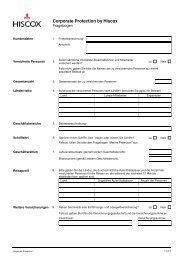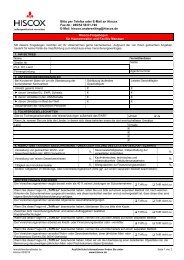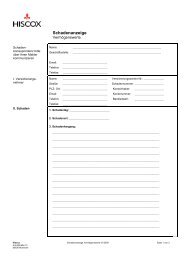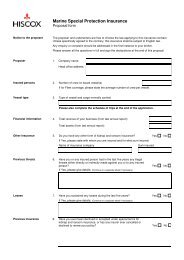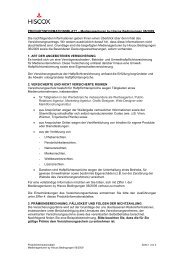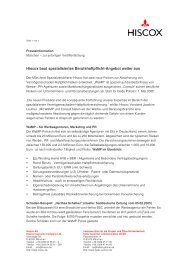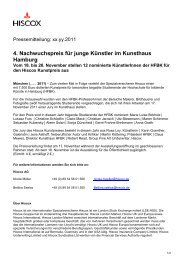Download PDF - Hiscox
Download PDF - Hiscox
Download PDF - Hiscox
You also want an ePaper? Increase the reach of your titles
YUMPU automatically turns print PDFs into web optimized ePapers that Google loves.
3 Management of risk continued<br />
3.1 Insurance risk continued<br />
that an insured event occurs, and a claim is<br />
subsequently submitted by the insured for<br />
payment. Management of insurance risk on<br />
a day-to-day basis is the responsibility of<br />
the Chief Underwriting Officer, who<br />
receives assistance from the management<br />
information and risk modelling departments.<br />
The Board sets the Group’s underwriting<br />
strategy for accepting and managing<br />
insurance risk prospectively, seeking to<br />
exploit identified opportunities and taking<br />
cognisance of other relevant anticipated<br />
market conditions. Specific underwriting<br />
objectives such as aggregation limits,<br />
reinsurance protection thresholds,<br />
geographical disaster event risk exposures<br />
and line of business diversification<br />
parameters are prepared and reviewed<br />
by the Chief Underwriting Officer in order<br />
to translate the Board’s summarised<br />
underwriting strategy into specific<br />
measurable actions and targets. These<br />
actions and targets are reviewed and<br />
approved by the Board in advance of each<br />
underwriting year. The Board continually<br />
reviews its underwriting strategy throughout<br />
each underwriting year in light of the<br />
evolving market pricing and loss conditions<br />
and as opportunities present themselves.<br />
The Board requires all underwriters to<br />
operate within an overall Group appetite<br />
for individual events. This defines the<br />
maximum exposure that the Group is<br />
prepared to retain on its own account for<br />
any one potential catastrophe event or<br />
disaster. The Group’s underwriting risk<br />
appetite seeks to ensure that it should not<br />
lose more than one year’s profit plus 15%<br />
of core capital as a result of a 1 in 250<br />
year event.<br />
Realistic disaster scenarios are extreme,<br />
hypothetical events selected to represent<br />
major events occurring in areas with large<br />
insured values. They also reflect the areas<br />
that represent significant exposures for<br />
<strong>Hiscox</strong>. The Group compiles estimates<br />
of losses arising from realistic disaster<br />
events using statistical models alongside<br />
input from its underwriters. The selection<br />
of realistic disaster scenario events is<br />
adjusted each year and they are not<br />
therefore necessarily directly comparable<br />
from one year to the next. The events are<br />
extreme and as yet untested, and as such<br />
these estimates may prove inadequate<br />
as a result of incorrect assumptions, model<br />
deficiencies, or losses from unmodelled<br />
risks. This means that should a realistic<br />
disaster actually eventuate, the Group’s final<br />
ultimate losses could materially differ from<br />
those estimates modelled by management.<br />
The Group’s underwriters and management<br />
consider insurance risk at an individual<br />
contract level, and also from a portfolio<br />
perspective where the risks assumed in<br />
similar classes of policies are aggregated<br />
and the exposure evaluated in light of<br />
historical portfolio experience and<br />
prospective factors. To assist with the<br />
process of pricing and managing insurance<br />
risk the Group routinely performs a wide<br />
range of activities including the following:<br />
regularly updating the Group’s risk<br />
models;<br />
documenting, monitoring and<br />
reporting on the Group’s strategy<br />
to manage risk;<br />
developing systems that facilitate<br />
the identification of emerging<br />
issues promptly;<br />
utilising sophisticated computer<br />
modelling tools to simulate<br />
catastrophes and measure the<br />
resultant potential losses before<br />
and after reinsurance;<br />
monitoring legal developments and<br />
amending the wording of policies<br />
when necessary;<br />
regularly aggregating risk exposures<br />
across individual underwriting<br />
portfolios and known accumulations<br />
of risk;<br />
examining the aggregated exposures<br />
in advance of underwriting further<br />
large risks; and<br />
developing processes that continually<br />
factor market intelligence into the<br />
pricing process.<br />
The delegation of underwriting authority<br />
to specific individuals, both internally and<br />
externally, is subject to regular review. All<br />
underwriting staff and binding agencies are<br />
set strict parameters in relation to the levels<br />
and types of business they can underwrite,<br />
based on individual levels of experience<br />
and competence. These parameters cover<br />
areas such as the maximum sums insured<br />
per insurance contract, maximum gross<br />
written premiums and maximum aggregated<br />
exposures per geographical zone and risk<br />
class. Monthly meetings are held between<br />
the Chief Underwriting Officer and a<br />
specialist central analysis and review team<br />
in order to monitor claim development<br />
patterns and discuss individual underwriting<br />
issues as they arise. The Chief Underwriting<br />
Officer also holds weekly video conference<br />
meetings with this team to discuss interim<br />
underwriting matters.<br />
The Group’s insurance contracts include<br />
provisions to contain losses such as the<br />
ability to impose deductibles and demand<br />
reinstatement premiums in certain cases.<br />
In addition, in order to manage the Group’s<br />
exposure to repeated catastrophic events,<br />
relevant policies frequently contain payment<br />
limits to cap the maximum amount payable<br />
from these insured events over the<br />
contract period.<br />
Another tool for managing insurance risk<br />
is reinsurance. Reinsurance protection<br />
such as excess of loss cover is purchased<br />
at an entity level and is also considered<br />
at an overall Group level to mitigate the<br />
effect of catastrophes and unexpected<br />
concentrations of risk. However, the<br />
scope and type of reinsurance protection<br />
purchased may change depending on<br />
the extent and competitiveness of cover<br />
available in the market.<br />
Notes to the consolidated financial statements <strong>Hiscox</strong> Ltd Report and Accounts 2009<br />
61




